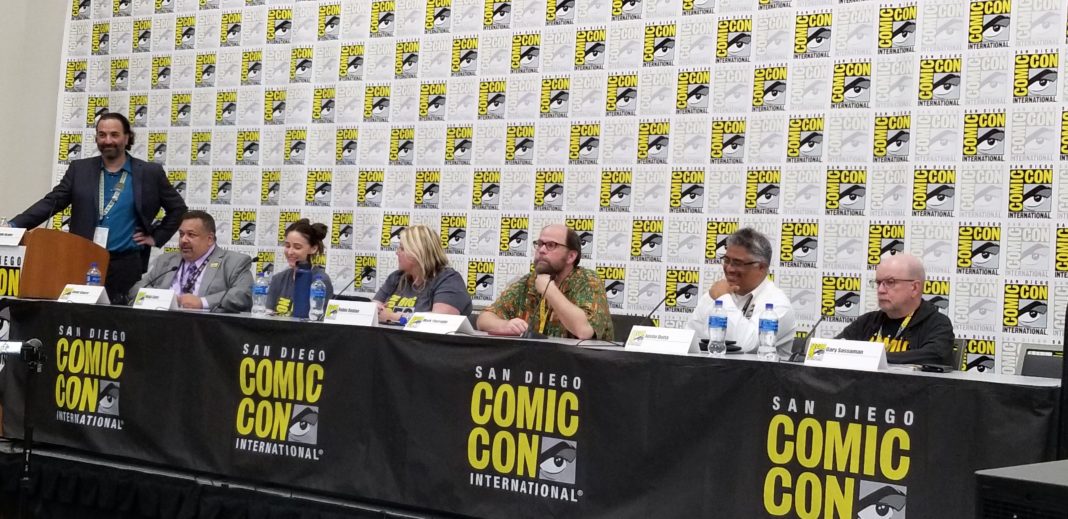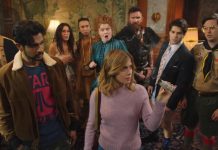By Gabriel Neeb
By the final day of the 2019 San Diego Comic-Con, all the panels commemorating the five decades leading to this convention had finished, and the leadership that worked to bring this year’s convention to fruition sat down to discuss where they started with the con, and where they are now in a panel called, simply, “Comic-Con Now.”
Moderated by Eddie Ibrahim, David Glanzer (Chief of Communications and Strategy), Maija Gates (Chief Experience Officer), Robin Donlan (President), Mark Yturralde (Chief Technology Officer), Justin Dutta (Exhibits Manager), and Gary Sassaman (Director, Print and Digital Publications) discussed how they ended up working at San Diego Comic-Con after starting, well, in lots of areas.
Ibrahim began by asking how the panelists came to Comic-Con and what their first positions were. Glanzer stated that if you knew how to do something, you quickly found a job at SDCC. This would prove common, as Sassaman started working as a freelancer with a background in graphic design, which soon led him to building Power Point presentations and then to Director of Print and Publications in 2007. That handy info guide attendees use is the result of six months of his work.
Yturralde started in 1977 as a security guard, at just 11 years old. He’s worked every Comic-Con International since, serving as Treasurer and a Board member, until he found himself as CTO for the last five years. Donlan joined SDCC in 1980 because she could run a 16mm film projector; this would lead to running the Masquerade, VP of Prints and Publications, professional registration, signage and Line Control.
Meanwhile, Gates began as an attendee who came to meet George Perez, cosplaying as Raven from New Teen Titans in the early 1980s. She officially joined in 1999, working exhibitor registration before entering talent relations and the fan engagement team in 2016. Glanzer himself had worked PR on political campaigns and was recruited quickly, finding himself now in communications and strategy. Ibrahim said he began as an information booth volunteer, back when there was an information booth.
As the show developed, the panelists had to develop with it. When most of the panelists began, SDCC was attended by 4,000-5,000 people and budgets were low, but not so low that even a small advertising budget ($2,000) could buy commercials on local TV stations.
As the show has grown, the small staffs mainly focused on getting to the next immediate goal. However, since attendance has plateaued (SDCC can’t expand beyond 130,000 attendees), the organizers can now focus on the larger experience and improve that.
Glanzer pointed out that even though Convention President John Rogers (who was able to keep so much of the workings of SDCC in his head) has passed on, Rogers’ dedication to providing a good experience for the fans compels the leadership in crafting every year’s event, including the Comic-Con Museum in Balboa Park.
As this is Donlon’s first year as president, her focus has been on the demands the con’s growth has presented. She observed that new departments often get created, and soon grow exponentially as the demand increases. She singled out the Line Management department as one that is the most prominent example of this phenomenon.
Yturralde would emphasize this in his answer to the question of how technology has helped the con grow. He remembered the con’s first computer: a PC AT which was used to manage mailing lists and what Mark referred to as a “demon possessed piece of junk” with no sentiment in his voice. Now, 30 cloud systems handle IT traffic comparable to the introduction of California’s health care system, Covered California, which has traffic resembling Comic-Con pre registration numbers — a time of notorious trouble.
Another area of interest has been Booth Management, which exists thanks to the efforts of Comic-Con staff and a host of fire marshals. As comics continue to go mainstream, the size of the crowds increase with the higher profile. At least now, there are fewer fist fights in the lines for exclusive toys.
As the “Comic-Con Now” panel continued, the issue of growing the con came up. From an attendance standpoint, SDCC cannot grow anymore, as mentioned above. However, the show has begun expanding its programming outside the convention center into the hotels and library. Inside the convention center, some booths have begun growing upwards, and the age of the two story booth may be coming, like this year’s DC Comics/Warner Bros. mega-booth.
There is also an initiative scheduled for the ballot in March 2020 which will pay for a convention center expansion, and that would actually allow for more attendees.
As for favorite memories of the panel, Gates remembered being able to help a young Canadian girl meet the Twilight cast through the Make-a-Wish Foundation as a highlight of her time with SDCC. Another remarkable memory was organizing the attendees of the 2015 Star Wars panel for a concert after the panel. That effort was more than just marching the hall out to the concert center, but required extensive coordination with local law enforcement and other civic organizations. It took months of planning.
Ibrahim countered that while this was amazing, it also left panelist Kevin Smith bereft of an audience for his Hall H presentation. Still, Smith went through with his panel and received some of the biggest applause he’d ever gotten.
For Donlon, a teacher in Chula Vista, she gets great satisfaction in telling her students about the convention… and them seeing them years later as volunteers and attendees.
Sassaman had a couple of great memories. One was setting up various graphic novel book clubs around the city; the other was coordinating the unannounced appearance of Sir Ian McKellen at the con in 2000, when McKellen had a Los Angeles layover while heading to New Zealand to shoot The Lord of the Rings. That the first X-Men movie had opened a week before was even better.
The panel reflected that to the outside world, it looks like SDCC comes together in a week, but to the panel, it is a team effort from the highest levels of leadership, to the freshest volunteers, and the invaluable feedback from the Comic-Con community as a whole. The show is great, because everybody loves it.








FYI: Gary Sassaman actually produces the big fat four-color Souvenir Book that is given out to everyone at Comic-Con, along with the Quick Guide. (The Events Guide with all the programs etc. is a separate publication.)
[…] Anyone who has had any dealings with SDCC on the professional level will have worked with Sassaman at some point, and he’s truly one of the most respected and well-liked folks behind the scenes . […]
Comments are closed.